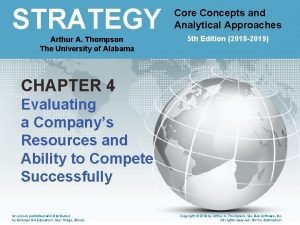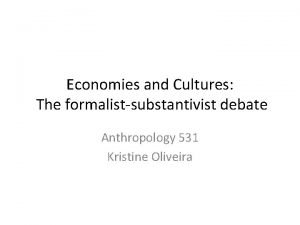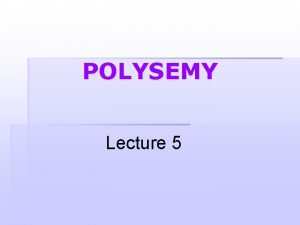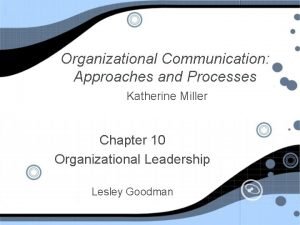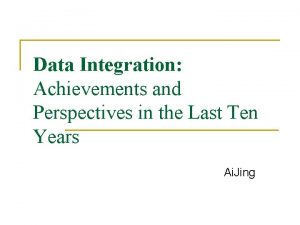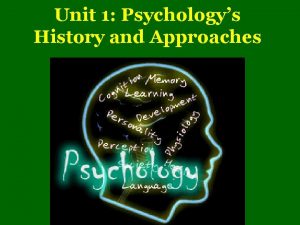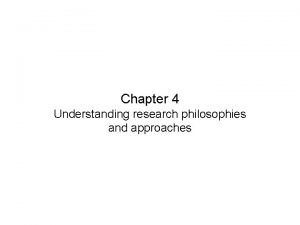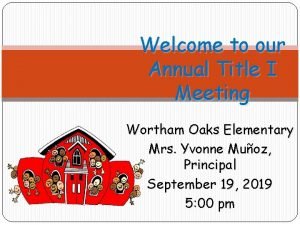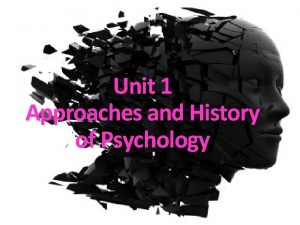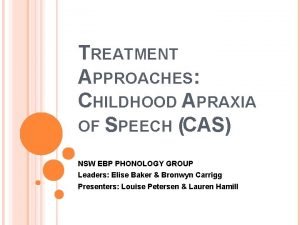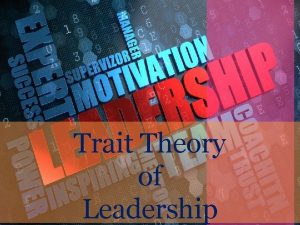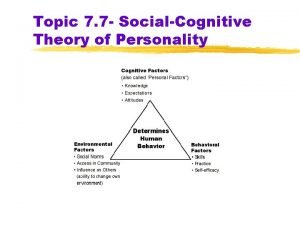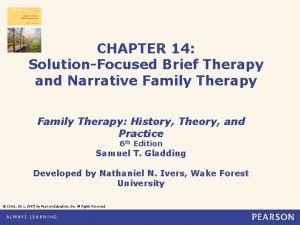Narrative and SolutionFocused Approaches Convergences Divergences and a





















![1993 • “… If [my] reflections on the… of Steve's work are reasonably well 1993 • “… If [my] reflections on the… of Steve's work are reasonably well](https://slidetodoc.com/presentation_image_h/094d19100264c358ce6f05f37ad6d698/image-22.jpg)















- Slides: 37

Narrative and Solution-Focused Approaches: Convergences, Divergences, and a Tribute Jeff Chang, Ph. D. , R. Psych. Associate Professor Graduate Centre for Applied Psychology Athabasca University Calgary, Alberta, Canada

Acknowledgements • Research and Study Leave Relocation Grant Permission • Feel free to use my work as long as you cite it. • Click here for publications and presentations.

Calgary, Alberta, Canada At the borderlands of the Stoney Lakota people and the Blackfoot people

Calgary, Alberta, Canada

Calgary, Alberta, Canada

Calgary, Alberta, Canada

Calgary, Alberta, Canada

Calgary, Alberta, Canada

Professional History Therapist for over 30 years, and a Registered Psychologist in Alberta for 27 years, working in: • children’s mental health as a: • Front-line counsellor • Clinical supervisor • Program developer and director (two schoolbased programs) • Employee assistance programs • Private practice

Professional History • Clinical Supervisor at Calgary Family Therapy Centre since 2011 Karl Tomm

Professional History

Rewind – 1985 • Working at a day treatment program for children with behavioral problems, my supervisor introduced me to the work of Steve de Shazer

Rewind… 1985 • “Keys” was an attempt to systematize brief strategic therapy • Characteristic of problems linked to types of interventions – a practical approach to Ericksonian utilization • “Skeleton keys” – usually something to do with asking about what was different when the problem was not occurring

1986 • Moved to Calgary and saw Michael White for the first time, as Karl Tomm had brought him to Calgary. • Calgary, along with Tulsa, OK, were among the first places in North America Michael taught

1987 • Michael came again to Calgary and spent a day at our agency, Wood’s Homes, an adolescent residential treatment centre • I was thrilled to bring a family for Michael to interview. Kori, an unruly 15 year old girl, had the agency chasing our tails. • Michael’s relentless curiosity, refusal to pathologize Kori and her family, and his invitation to reflect on a preferred future, were compelling.

1988 -1990 • My colleagues and I began to notice, and then present locally, on the similarities and differences between Michael’s work (at that time we were only vaguely aware of his partnership with David Epston) and Steve’s work (along with Insoo Kim Berg, Eve Lipchik, and others). • I learned of an upcoming conference “Generating Possibilities Through Therapeutic Conversations” (TC I) to be held in Tulsa, OK, in June 1991. • I managed to talk my way into doing a

1991 “TC I”, Tulsa, Oklahoma, June 1991 TC I was an inflection point!

1993 Resulting in…. Chang, J. , & Phillips, M. (1993). Michael White and Steve de Shazer: New directions in family therapy. In S. Gilligan & R. Price (Eds. ), Therapeutic conversations. New York: Norton.

1993 • Michele Phillips and I noticed primarily the emphasis on asking about what clients were doing when clients are experiencing a preferred outcome • We attempted to find some common conceptual roots (Bateson, sociology, deconstructionist philosophers [Derrida, Heidigger], Milton Erickson!? ) • We suggested that what Michael and Steve were doing was

1993 • In Steve’s commentary on our chapter, he disagreed with pretty much everything we said. • He noted a “radical distinction” between “unique outcomes” and “exceptions, ” and between “antiproblem” and “solution. ” • He suggested that Michael’s 1986 description of “a new code book” constituted an “objective reality” and therapist imposing “a better way”

1993 • Michael commented that Steve’s description of his work “rendered it mostly unrecognizable to me…. ” • Michael identified Steve’s intellectual rigour and the nonpathologizing nature of SFT, continuing:
![1993 If my reflections on the of Steves work are reasonably well 1993 • “… If [my] reflections on the… of Steve's work are reasonably well](https://slidetodoc.com/presentation_image_h/094d19100264c358ce6f05f37ad6d698/image-22.jpg)
1993 • “… If [my] reflections on the… of Steve's work are reasonably well founded, then I do believe that my work can, to an extent, be aligned with his. This reflection enables me to entertain the idea that we might share some common purposes, and it might further explain why others have, on occasion, made the assumption that we are kindred spirits…. ” • They agreed that their approaches had a certain “family resemblance” – like

The Years Surrounding TC 1 Movement from charismatic (usually male) therapists being very directive, and pronouncements from behind the one-way mirror (it really was “one way”), to: • Reflecting teams (Andersen, 1989) • “Glasnost”(Furman, 1992) • Problem determined systems – Collaborative Languages Systems (Anderson & Goolishian, 1989, 1992) • The Milan team – circular questioning (Cechin, 1992; Fleuridas, Nelson, & Rosenthal, 1986)

The Years Surrounding TC 1 • Solution-focused therapists: • Recognized the centrality of the interview, as opposed to the “intervention” (pronouncement from behind the mirror) (Lipchik & de Shazer, 1986) • Going even further, de Shazer cited Wittgenstein: “The limits of my language means the limits of my world. • Future questioning (Penn, 1982, 1985) • Interventive interviewing (Tomm, 1987 a, 1987 b, 1988)

The Years Surrounding TC 1 “It was a very exciting and generative time. Structural and strategic approaches were dominant then. The field was shifting from a first order perspective, in which therapists were operating upon clients, to a second order perspective in which therapeutic system included therapist. The field was undergoing a shift in how it viewed epistemology and the nature of truth, and [TC I] accelerated that shift. The conference made it possible to transcend schools of therapy and look at collaborative practices that had much more in common than people

1994 -1996 • Steve and Michael presented together in 1994 at TC II • The hoped-for (at least on my part) crossgermination seemed to stop after 1996 What stuck? A postmodern view of language: • Language constitutes or constructs reality, as opposed to representing reality • Michael referred to this as “constitutionalism” • “There is no reality apart from language” (de Shazer, 1994)

A Postmodern View of Language As Shotter (1993, p. 20) observes, in a constitutive view of language: • “We unknowingly ‘shape’ or ‘construct’ between ourselves. . . not only a sense of our identities, but also a sense of our ‘social worlds. ’” • Narrative and solution-focused therapists knowingly shape identities and social worlds through the interview process, but differ “about the most helpful way to steer. . . the conversation. . . ” (Mills & Sprenkle, 1995, p. 369).

Micro vs. Macro • In keeping with the macro/micro distinction solution-focused therapists steer the conversation toward hypothetical solutions, exceptions to the problem, and solution descriptions. • From the inside out • Narrative therapists elicit descriptions of a client’s agency in relation to the problem, and deconstruct the discourses that support the problem. • From the outside in

Social Justice Narrative therapists deconstruct discourses that support problems, such as: • Gender stereotypes • Traditional conceptions of sexual expression • Ideas of ability and disability • Conceptions of physical beauty • Colonialism • Medicalizing discourses…

Social Justice … which leads us to question the premises of these discourses … which leads us to reflect on how life is lived… … which leads us live consciously position ourselves in relation to these discourses… … which (may) lead us externalize the problem… … which leads us to resist in in solidarity with one another… … which leads us to document our resistance and solidarity… … which results in more socially just practice

Social Justice Yvonne Dolan on Steve’s approach to social justice: • “What I heard him say is that he thought they were apples and oranges. And the funny thing is, you know, as a person, he was a complete lefty. I’ve watched him take out every dime and dollar in his pocket and give it to a street person. He was absolutely prejudiced [in favor of] minorities of any kind. . However, he felt that to try to look at that in terms of therapeutic approach, for him, interfered with him being able to figure out what he called external signifiers—the way that

Social Justice • “… But, he. . . could not entertain both at the same time. He felt very strongly, as a person, that [he should be acting to correct] injustices. However, he did not find it meaningful, or he did not find a way, or both, to put that in his therapeutic approach. But I think that he would have been very disappointed in someone as a person if they saw an injustice going on [and did not try to correct it]. ”

What’s Happening Now? • These approaches are embedded in curriculum and textbooks in counselling, psychology, clinical social work, etc. • We’ve left therapy room • Narrative community work • Solution-focused coaching • Solution-focused community development

What’s Happening Now? • We are part of a big family of post-modern or social constructionist practice • Jakko Seikkula, Finland, Open Dialogue Method • Ben Furman, Finland, Kid. Skills and Reteaming • Imelda Mc. Carthy, Ireland, The Fifth Province • Olga Runciman, Denmark, Hearing Voices Network • Karl Tomm, Canada, Calgary Family Therapy Centre • Andrew Turnell, Perth, WA, Signs of Safety • David Cooperrider, Appreciative inquiry • We still don’t talk with each other much • More differentiation and not much cross-pollination

What’s Happening Now? • For better or for worse, we are lumped in with: • The “Resiliency” approach • “Strengths-Focused” work • Positive Psychology • The Recovery Model • Focusing on what is going well is good, right? • On the other hand, both Michael and Steve disavowed the idea that they are looking for “strengths” that reside within individuals, for this would logically require us to locate deficits within individuals

The Big Question SO WHAT? • For some, mixing and matching approaches is fine • Practitioners gravitate to ways of working that “fit” • For others, it’s more important to reflect closely on our work • Engaging in self-clarification, part of which is differentiation

Finally, a Tribute
 Personal narrative vs narrative
Personal narrative vs narrative Personal narrative vs fictional narrative
Personal narrative vs fictional narrative Wid approach
Wid approach Strategy: core concepts and analytical approaches
Strategy: core concepts and analytical approaches Semantic structure of a word
Semantic structure of a word Expressive criticism example
Expressive criticism example Substantivist vs formalist
Substantivist vs formalist Content based task based and participatory approaches
Content based task based and participatory approaches What are the 5 approaches to health promotion
What are the 5 approaches to health promotion Ib approaches to learning
Ib approaches to learning Language testing approaches and techniques
Language testing approaches and techniques Mode of discourse in register
Mode of discourse in register What are the 5 types of non experimental research design
What are the 5 types of non experimental research design Direct/expository instruction approach
Direct/expository instruction approach Historical changeability of semantic structure
Historical changeability of semantic structure Ap psychology module 2 review
Ap psychology module 2 review Develop new approaches to public governance and engagement
Develop new approaches to public governance and engagement Supplier evaluation techniques
Supplier evaluation techniques Katherine miller organizational communication
Katherine miller organizational communication Data cleaning problems and current approaches
Data cleaning problems and current approaches Data integration problems approaches and perspectives
Data integration problems approaches and perspectives Pricing considerations and approaches
Pricing considerations and approaches Learning approaches theory and practice
Learning approaches theory and practice What is linguistics
What is linguistics Linear perspective ap psychology
Linear perspective ap psychology Power bi governanace
Power bi governanace Research philosophies and approaches
Research philosophies and approaches Approaches meets masters
Approaches meets masters Approaches to psychology
Approaches to psychology Cas treatment approaches
Cas treatment approaches Trait theories
Trait theories Trait approaches to leadership
Trait approaches to leadership External locus of control psychology definition
External locus of control psychology definition Approaches to tourism planning
Approaches to tourism planning What are the three approaches to security?
What are the three approaches to security? Chapter 3 the pearl
Chapter 3 the pearl Statutory interpretation
Statutory interpretation Step wise project planning
Step wise project planning



